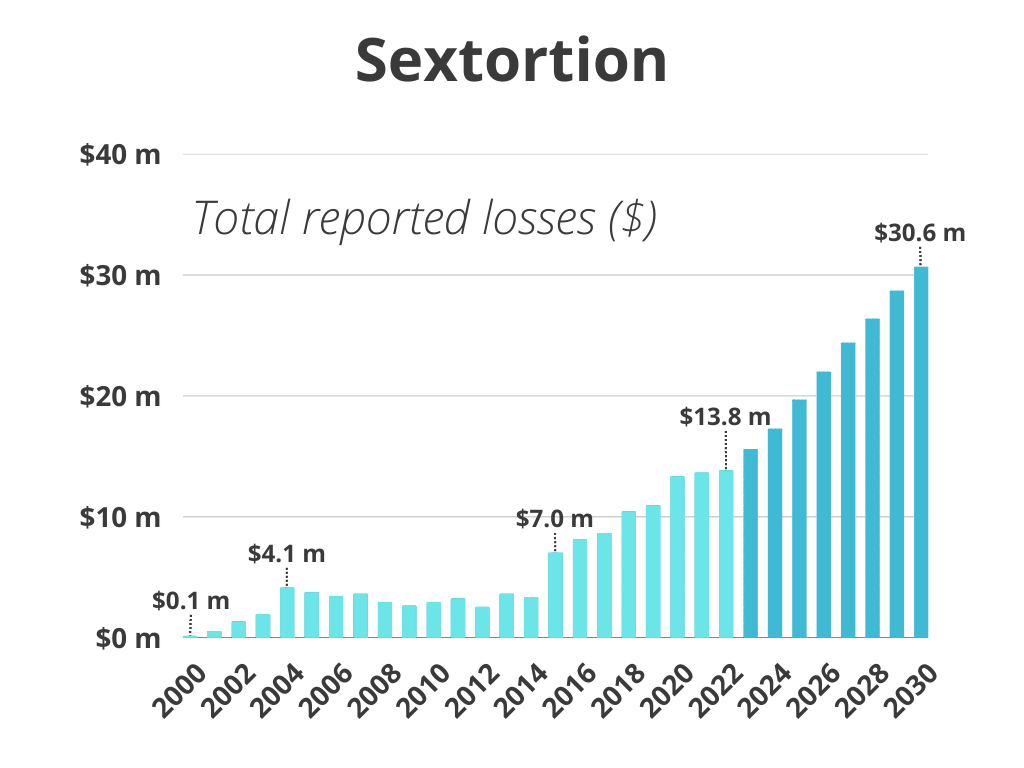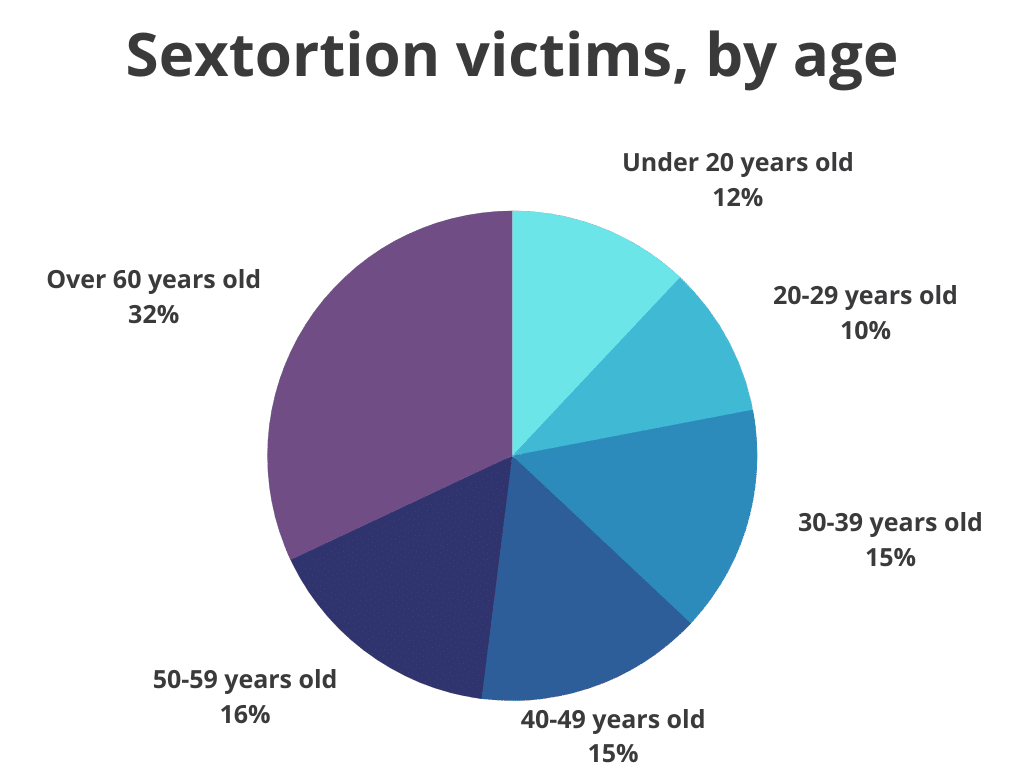![The Rise Of Sextortion [Statistics & Facts]](https://wp.bedbible.com/wp-content/uploads/2024/06/The-Rise-Of-Sextortion-Statistics-Facts.png)
The digital world leads to some positive and negative things. A negative thing we’ve heard more and more about, and that we’ll unfortunately continue to hear about is the rise of sextortion.
Sextortion is the crime of luring people into sending explicit images and videos and hereafter threatening them to share it publicly.
We’ve analyzed this topic in this article to get a better understanding of how widespread the phenomenon is.
Table of contents:
- Total Number of Reported Cases Per Year
- Total Financial Losses Per Year
- Sextortion Victims, By Age
- The Un-reported Numbers of Sextortion
- Other Facts
- Technology/platforms Used For the Crime
- Content of Images Used For Sextortion
- What do Perpetrators Want?
- The Type of Threats
Key Takeaways
- Sextortion is so common that an estimated 120,000 Americans are victims of it each year (with $81 million in financial losses).
- 20,247 cases of sextortion are reported yearly (increases 35% each year).
- More than $13.8 million are blackmailed through sextortion (increases +41% each year).
- 65% threaten the victim to post the contents of the explicit exchange online.
- 51% of perpetrators extort victims to get them to send more explicit content.
- 12% of sextortion victims are under 20 years old.
- 37% of victims who complied with the demands of sextortion said the threats stopped.
- 47% of sextortion victims got daily threats.
Total Number of Reported Cases Per Year
Through the use of the US IC3 (Internet Crime Complaint Center) database of annual sextortion reporting, we found that:
- More than 20,200 sextortion cases are reported annually.
- The number of sextortion cases reported each year has grown on average +35% each year (since 2000).
- The number of reported sextortion cases is expected to grow to 45,000 by 2030.

| Year | Sextortion reportings | YoY % increase in reportings |
|---|---|---|
| 2000 | 201 | – |
| 2001 | 671 | 234% |
| 2002 | 1,930 | 188% |
| 2003 | 2,733 | 42% |
| 2004 | 6,084 | 123% |
| 2005 | 5,432 | -11% |
| 2006 | 4,977 | -8% |
| 2007 | 5,311 | 7% |
| 2008 | 4,271 | -20% |
| 2009 | 3,859 | -10% |
| 2010 | 4,241 | 10% |
| 2011 | 4,655 | 10% |
| 2012 | 3,679 | -21% |
| 2013 | 5,271 | 43% |
| 2014 | 4,836 | -8% |
| 2015 | 10,283 | 113% |
| 2016 | 11,957 | 16% |
| 2017 | 12,636 | 6% |
| 2018 | 15,201 | 20% |
| 2019 | 15,967 | 5% |
| 2020 | 19,523 | 22% |
| 2021 | 19,974 | 2% |
| 2022 | 20,247 | 1% |
| 2023 | 22,677 | 12% |
| 2024 | 25,171 | 11% |
| 2025 | 28,695 | 14% |
| 2026 | 32,138 | 12% |
| 2027 | 35,674 | 11% |
| 2028 | 38,528 | 8% |
| 2029 | 41,995 | 9% |
| 2030 | 44,935 | 7% |
Total Financial Losses Per Year
While sextortion scams typically involve the predator wanting more explicit images out of the victim, some cases involve financial losses.
The monetary loss for each reported case is also available in the IC3 database to calculate the reported losses to sextortion for each year since 2000.
- The total financial losses to sextortion was $13.8 million annually.
- The annual losses to sextortion have increased by +41% annually.
- The financial losses to sextortion are expected to almost triple to $30+ million by 2030.

| Year | Financial losses | YoY %-increase of losses |
|---|---|---|
| 2000 | $0.1 million | – |
| 2001 | $0.5 million | 400% |
| 2002 | $1.3 million | 160% |
| 2003 | $1.9 million | 46% |
| 2004 | $4.1 million | 116% |
| 2005 | $3.7 million | -10% |
| 2006 | $3.4 million | -8% |
| 2007 | $3.6 million | 6% |
| 2008 | $2.9 million | -19% |
| 2009 | $2.6 million | -10% |
| 2010 | $2.9 million | 12% |
| 2011 | $3.2 million | 10% |
| 2012 | $2.5 million | -22% |
| 2013 | $3.6 million | 44% |
| 2014 | $3.3 million | -8% |
| 2015 | $7 million | 112% |
| 2016 | $8.1 million | 16% |
| 2017 | $8.6 million | 6% |
| 2018 | $10.4 million | 21% |
| 2019 | $10.9 million | 5% |
| 2020 | $13.3 million | 22% |
| 2021 | $13.6 million | 2% |
| 2022 | $13.8 million | 1% |
| 2023 | $15.5 million | 12% |
| 2024 | $17.2 million | 11% |
| 2025 | $19.6 million | 14% |
| 2026 | $21.9 million | 12% |
| 2027 | $24.3 million | 11% |
| 2028 | $26.3 million | 8% |
| 2029 | $28.6 million | 9% |
| 2030 | $30.6 million | 7% |
Sextortion Victims, By Age
The current data online of what age groups are most often the victims of sextortion has unfortunately brought forth extremely biased numbers.
The dataset most often mentioned has been gathered as a voluntary survey amongst a victim group from the Crimes Against Children Research Center (CCRC). In other words, it is no wonder, that the results from the survey of 1,631 respondents gathered in this manner show that:
- 1 in 4 (25%) victims were 13 years old or younger when they were victims of sextortion.
- 2 in 3 (67%) victims of sextortion were girls younger than 16 years old.
Although it is horrifying numbers it is not a representative sample and therefore do not show the true picture of the age discrepancies.
From the case files of all the reported sextortion cases we find that a more likely distribution across age groups is:
- 12% of sextortion victims are under 20 years old.
- 10% of sextortion victims are 20-29 years old.
- 15% of sextortion victims are 30-39 years old.
- 15% of sextortion victims are 40-49 years old.
- 16% of sextortion victims are 50-59 years old.
- 32% of sextortion victims are over 60 years old.
- In other words, in almost 1 in 3 reported cases of sextortion, the victim was older than 60 years old.
It does, however, also mean that of the 20,247 reported sextortion cases:
- In +2,000 reported sextortion cases the victim was a minor.
- Close to 6,500 cases of sextortion were targeted at the elderly (60+).

The Un-reported Numbers of Sextortion
A survey amongst 1,631 respondents, who were all victims of sextortion at some point in their lives showed that:
- Only 17% of sextortion victims report the crime to law enforcement.
In other words, to estimate the real number of sextortion victims annually we would have to take this into account.
As we only have the true number of actual reported cases in the IC3 database, the below are best estimates (using the knowledge that 17% of all cases are reported).
We can on this background find that:
- It is estimated that +120,000 Americans become victims of sextortion each year.
- It is estimated that $80+ million are lost to sextortion predators each year.
- It is expected that the number of sextortion victims will grow to 264,322 victims by 2030.
If calculate the estimated numbers for each age group we find that:
- 14,292 of US sextortion victims were under the age of 20.
- 11,910 of US sextortion victims were between 20-29 years old.
- 17,865 of US sextortion victims were between 30-39 years old.
- 17,865 of US sextortion victims were between 40-49 years old.
- 19,056 of US sextortion victims were between 50-59 years old.
- 38,112 of US sextortion victims were over the age of 60.
| Year | Estimated sextortion victims | Estimate financial losses |
|---|---|---|
| 2000 | 1,182 | $0.6 million |
| 2001 | 3,947 | $2.9 million |
| 2002 | 11,353 | $7.6 million |
| 2003 | 16,076 | $11.2 million |
| 2004 | 35,788 | $24.1 million |
| 2005 | 31,953 | $21.8 million |
| 2006 | 29,276 | $20 million |
| 2007 | 31,241 | $21.2 million |
| 2008 | 25,124 | $17.1 million |
| 2009 | 22,700 | $15.3 million |
| 2010 | 24,947 | $17.1 million |
| 2011 | 27,383 | $18.8 million |
| 2012 | 21,643 | $14.7 million |
| 2013 | 31,004 | $21.2 million |
| 2014 | 28,446 | $19.4 million |
| 2015 | 60,485 | $41.2 million |
| 2016 | 70,335 | $47.6 million |
| 2017 | 74,329 | $50.6 million |
| 2018 | 89,420 | $61.2 million |
| 2019 | 93,924 | $64.1 million |
| 2020 | 114,841 | $78.2 million |
| 2021 | 117,494 | $80 million |
| 2022 | 119,100 | $81.2 million |
| 2023 | 133,392 | $91.2 million |
| 2024 | 148,065 | $101.2 million |
| 2025 | 168,794 | $115.3 million |
| 2026 | 189,050 | $128.8 million |
| 2027 | 209,845 | $142.9 million |
| 2028 | 226,633 | $154.7 million |
| 2029 | 247,030 | $168.2 million |
| 2030 | 264,322 | $180 million |
Other Facts
- 47% of sextortion victims got daily threats.
- 60% of sextortion victims online were extorted within 2 weeks of meeting the perpetrator.
- 54% of sextortion victims disclosed it to one or more family members.
- 26% of sextortion victims reported the incident online (to a sextortion platform or website).
- 17% of sextortion victims report the crime to law enforcement.
- 83% of online reported sextortion victims are women (14% men, and 3% non-binary).
- 78% of reported cases had a White/Caucasian victim
- 4% of reported cases had a Black/African American victim.
- 3% of reported cases had an Asian victim.
- 2% of reported cases had an American Indian/Alaska native victim.
- 1% of reported cases had a Native Hawaiian/Pacific Islander victim.
- 60% of victims had a face-to-face relationship with the extorter.
- 40% of victims only ever met their extorter online.
- Men are twice as likely to become victims of sextortion with someone they have only met online (compared to women).
- 51% of victims felt pressured to send nudes in the first place.
- 15% of sextortions tricked their victims into sending nudes.
- 40% of sextortion victims freely provided explicit images of themselves.
- 53% of sextortion victims comply with the demands of the perpetrator.
- Only 37% of victims who complied with the demands of sextorting said the threats stopped.
- 5% of victims move to a new town.
- 21% of victims saw a therapist.
- 9% of victims either change jobs or school.
Technology/platforms Used For the Crime
Victims of sextortion report to use the following platforms when meeting their extorter:
- 54% met the sextorter on social media platforms (Facebook, Instagram, TikTok).
- 41% met the sextorter on messaging platforms (Snapchat, Kik, WeChat).
- 23% met the sextorter on video call apps (Facetime, Skype, webcam sites).
- 9% met the sextorter on dating platforms and apps (OKCupid, Tinder).
- 12% met the sextorter by email.
- 6% met the sextorter on video-based social media platforms (Vine, Oovoo, Tumblr).
- 4% met the sextorter on gaming platforms (Discord, Twitch).
Content of Images Used For Sextortion
- 29% of victims of sextortion were extorted with images of sexual acts, masturbation, or sex with another person.
- 30% of victims of sextortion were extorted with images of genitals.
- 22% of victims of sextortion were extorted with images of nudity (but no genitals)
- 14% of victims of sextortion were extorted with images of sexual poses, sometimes in revealing clothing, like underwear.
What do Perpetrators Want?
- 51% of sextortion attempts are done to acquire additional sexual photographs or videos from the respondent.
- 42% of victims of sextortion said that the perpetrator was a partner (former or current) who blackmailed them to stay in or return to a relationship.
- 28% of perpetrators use sextortion to tell the victims how to look or what to do in pictures or videos.
- 26% of perpetrators wanted to meet the respondent in person and use sextortion to force them into agreeing.
- Only 9% of perpetrators blackmail the respondent for money.
- 7% of sextortion victims are asked to take nude videos or images of others.
The Type of Threats
- 65% threaten the victim to post the contents of the explicit exchange online.
- 59% threatened the victim to send the contents of the explicit exchange to friends and family of the victim.
- 37% threatened the victim to tell the victim’s family or friends about the explicit exchange.
- 37% threatened the victim to share the contents of the explicit exchange including their name and information.
Some perpetrators even threatened with physical harm:
- 31% of victims got threats of stalking.
- 26% of victims were threatened with rape, beatings, and even murder.
- 15% of victims received threats against their family or friends.
